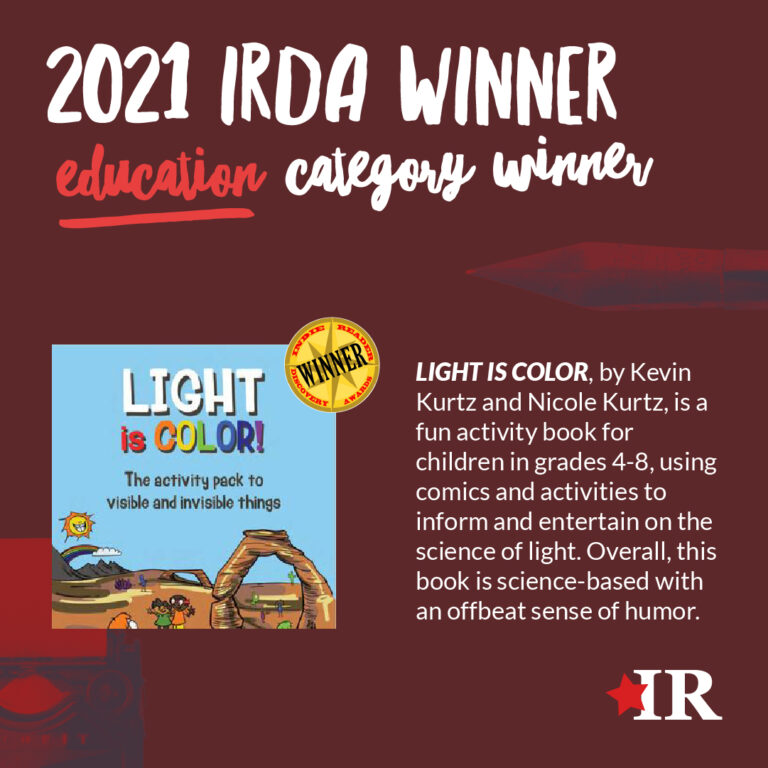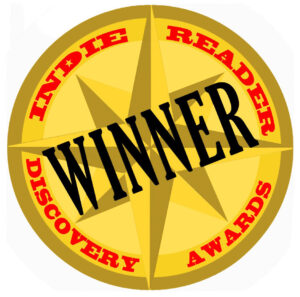Light is Color! was the winner in the Education category of the 2021 IndieReader Discovery Awards, where undiscovered talent meets people with the power to make a difference.
Following find an interview with authors Nicole Kurtz + Kevin Kurtz.
What is the name of the book and when was it published?
Light is Color! The comic (and coloring and activity) guide to visible and invisible things. It was self-published by Kurtoonz Studios in 2020
What’s the book’s first line?
“Wow! Light is amazing!”
What’s the book about? Give us the “pitch”.
How is a lightning bug’s light different from the light from the screen of an iPad? What does Betelgeuse have to do with an armpit? Why do rainbows always appear in the same colors? What does eating, breathing, and not dying have to do with plants being green? If sugar has solar energy, then why don’t you need to wear sunglasses when you look at a candy bar?
Discover the answers to these questions and more in this comic (and coloring and activity) guide to visible and invisible things!
Light is Color is a graphic novel accompanied with activities to test your knowledge on all things light. And, it can be used as a coloring book too! The pages are thick enough so crayon markings won’t show through to the next page.
Aligned to the 4th-8th Next Generation Science Standards, this book covers essential topics such as: absorption; transmission, reflection, and refraction of light waves; transparency, translucency, and opacity of materials; convex and concave lenses; the electromagnetic spectrum, prisms and wavelengths; additive and subtractive color in art; the transfer of heat energy; the process of photosynthesis. Readers can also explore different career opportunities utilizing this knowledge base.
Irreverent and informative, funny and functional, this book was created by a team of dedicated educators and science communicators.
What inspired you to write the book? A particular person? An event?
Nicole Kurtz was inspired to create this resource after a conversation she had with her brother, who teaches elementary level science to underserved populations in Cleveland, Ohio. He lamented the lack of quality science resources – especially ones that could help his students grasp complex and intangible concepts, like light waves. As an artist dedicated to using her skills to help others get the most out of their education, she knew she could assist.
Nicole Kurtz has worked with Kevin Kurtz (seriously, no relation!) on previous educational animations and traveling science exhibits since 2013. Their love of science communication brought them individually to the International Ocean Discovery Program where they sailed as Outreach Officers on expeditions communicating the science onboard to classrooms around the world.
Nicole’s quirky illustrations paired with Kevin’s off-beat writing create a jam-packed comic that jumps from topic to topic with an easy-to-follow connected flow.
What’s the most distinctive thing about the main character? Who-real or fictional-would you say the character reminds you of?
I love that the three main characters, (Roy Gee and Biv) are a team. They each have an area of expertise within the concepts of light and take turns sharing their knowledge with one another. It’s a book for elementary level students being told by elementary level students.
What’s the main reason someone should really read this book?
From the informative writing style to the quick-witted illustrations, readers are sure to always notice something new with each read! The self-referential humor and cheeky diagrams make the process of learning about light entertaining and memorable.
If they made your book into a movie, who would you like to see play the main character(s)?
Kevin Kurtz (KK): So, I’m going to assume this will be an animated movie and these are voice actors playing the kid characters. I’d like J. B. Smoove to play Roy, Kristin Wiig to play G, and Will Ferrell to play Biv.
When did you first decide to become an author?
Nicole Kurtz (NK): I always liked to draw, but it was in high school when I realized the power of illustrations to convey non-verbal messages. In college, I picked up journaling and started to combine my words and illustrations.
KK: I started thinking that around age 9 or 10. That’s when I started having my own ideas for stories and started writing and drawing my own comics. The older I got, the more becoming an author became my goal (particularly as I slowly realized that no one was going to pay money to look at something I drew).
Is this the first you’ve written?
NK: This is the first one I’ve officially published.
KK: I actually have over 20 traditionally published nonfiction children’s books that I have written, but this is the first book written as a comic that I have had published.
What do you do for work when you’re not writing?
NK: I live with my husband in Austin, Texas, where I design educational resources for children on the autism spectrum. I also teach art classes in the summer, and freelance as a forensic animator.
KK: When I first started getting published, I was an educator at an aquarium, then at a bird of prey center, and then at a science museum. Now I do some contract work developing education and outreach materials for science organizations. I also work part-time at a company that develops training materials for other businesses.
How much time do you generally spend on your writing?
NK: I like doodling/writing first thing in the morning before my brain has a chance to fully wake up. That usually sets the tone for the day. Sometimes I get so engrossed before I realize it’s already noon. Early scheduled meetings unfortunately break me out of this zone on other days.
KK: Ideally, I want to spend 2-3 hours a day doing my own writing, but that doesn’t always happen because of, you know, life.
What’s the best and the hardest part of being an indie?
NK: This was the first book I’ve ever published. The hardest part was probably having to stumble my way through the process and the upfront out-of-pocket costs. But, the best part is the sense of pride holding the finished product. There’s a tremendous sense of accomplishment when you have a hand in every step of the process. Seeing your idea go from scribbles on sheets of paper to a printed and bound book – that wins an award! – is inspiring (and addicting!)
KK: The best part of being an indie is it allows your book to completely match your creative vision (you give up a bit of creative control with traditional publishers). The hardest part is getting people to realize that your book exists.
Would you go traditional if a publisher came calling? If so, why?
NK: I might try it once to know what steps of the process I missed publishing on my own haha!
KK: I still want to continue working with traditional publishers, as they take the financial gamble up front, have the distribution networks to make your book easily available in places around the world, and provide you with a level of status that opens doors to things like school visits and children’s book conferences. But I definitely like the creative control that indie publishing provides and that has made it much more enticing to me.
Is there something in particular that motivates you (fame? fortune?)
NK: Watching a lightbulb go off in someone’s head when they’ve finally understood a challenging concept motivates me. I love that I can accomplish this with illustrations and words while making them laugh in the process.
KK: No one should become a writer solely to seek fame and fortune (if that’s your goal, Instagram, TikTok, or YouTube are much better bets). I do it mainly because I love the creative process of writing and being published provides me more opportunities to spend my time being creative.
Which writer, living or dead, do you most admire?
NK: Shel Silverstein. I still remember his poems and illustrations many years after flipping through one of his books. On the surface, his poems can appear nonsensical but they offer a humanity and self-reflection I love.
KK: If I have to pick just one, I will go with Charles Schulz. I was a huge Peanuts fan as a kid. He was the main inspiration that got me writing and drawing my own comics around age 9. As an adult, I am blown away by his ability to create characters with complex inner lives while also regularly making me laugh out loud.
Which book do you wish you could have written?
KK: I’ll go with Song of the Dodo by David Quammen. It is a beautifully and entertainingly written nonfiction book about island biogeography, a concept that most people have never heard of, but reading it in my early 20’s changed my understanding of nature and also opened my eyes to the creative possibilities of writing nonfiction.

